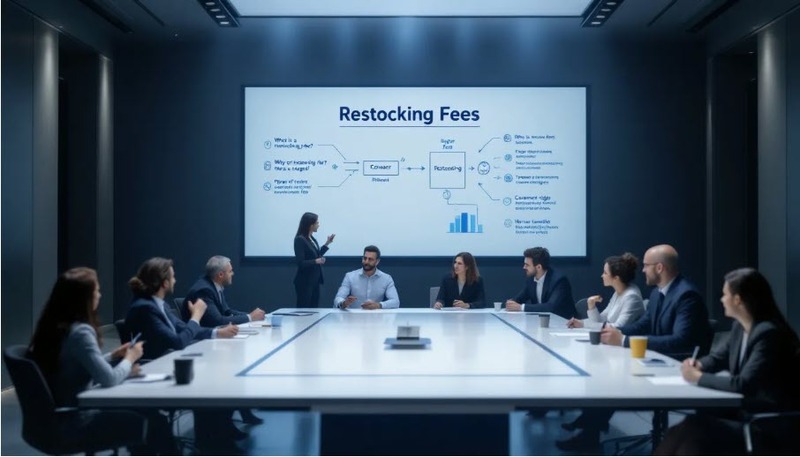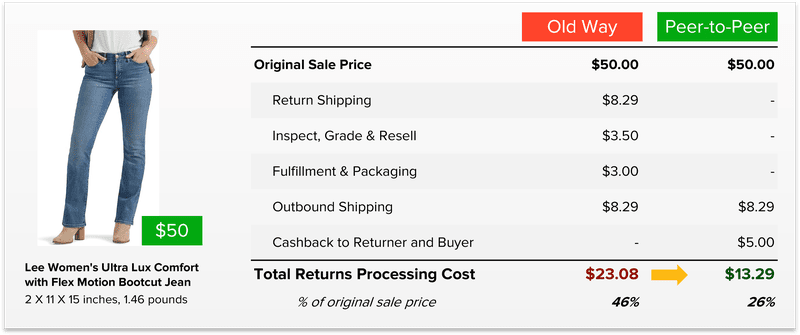What is a Restocking Fee, And Alternative Options

Last updated on March 28, 2025

In this article
 10 minutes
10 minutes
You just returned a $500 gadget—only to find $100 missing from your refund. What happened? That’s the sting of a restocking fee. A restocking fee is a charge that retailers apply when customers return products. This fee helps cover the costs associated with processing the return, like labor, inspection, and repackaging. Understanding what a restocking fee is can help you avoid unexpected costs when making returns.
Key Takeaways
- Restocking fees are charges imposed by retailers when customers return products, usually ranging from 10% to 25%, to cover processing costs.
- Factors like the condition of the returned item, return timing, and whether original packaging is included influence the amount of the fee.
- Customers can understand return policies, negotiate with retailers, or opt for store credit instead of refunds to avoid or reduce restocking fees.
Understanding Restocking Fees
Restocking fees are charges that retailers apply when customers return products. These fees are intended to offset costs associated with processing the return, such as labor, inspection, and repackaging. For consumers, understanding restocking fees is crucial to avoid unexpected costs and make informed buying decisions. Retailers are legally required to clearly disclose these fees to maintain transparency.
Considering the likelihood of returning a product and inquiring about any potential restocking fees before purchase is a prudent approach. Such proactive measures help manage expenses and prevent surprises.
Understanding what these fees entail and why they exist can provide further clarity.
Definition of Restocking Fee
A restocking fee is applied by a retailer when a customer returns a product. This fee is deducted from the refund amount. This fee is typically a percentage of the item’s value, designed to cover the cost of processing and restocking the returned item. These fees usually range from 10% to 25% of the item’s price, but can vary based on the store’s policy and the condition of the returned item.
Different companies have different policies regarding restocking fees. For instance, restocking fees for electronics can typically range from 15% to 20% of the item’s initial price. Opened packages of computer software and hardware can also incur restocking fees due to the complexity of returning these items.
Knowing these variations allows for better anticipation of potential costs.
Purpose of Restocking Fees
Retailers often charge restocking fees to recover costs associated with processing returns, including labor, handling, and shipping. The process of inspecting, repackaging, and restocking items can be labor-intensive and costly, which is why these fees exist. Additionally, the longer an item is out of the store, the more likely it is to incur a higher restocking fee due to potential depreciation, expiration, and/or lapsed seasonality.
Approximately three-quarters of retailers apply restocking fees on returns, highlighting their widespread usage. The return period can also influence the fee, with shorter return windows generally resulting in lower fees. Delays in returning items can lead to higher restocking fees, as retailers factor in the time elapsed since the purchase, and thus, the likelihood of resalability.
Being aware of these factors can help avoid higher fees while supporting more effective returns management.
Common Scenarios Where Restocking Fees Apply
Restocking fees typically vary by retailer and may depend on the product category. These fees are often applied when items are returned for reasons like buyer’s remorse or a change of mind. Returns initiated after the standard return period may also lead to restocking fees being applied.
However, returned item fees are generally not charged when there is something wrong with the product, such as damage in shipping or a manufacturer defect.
Electronics and Computer Software
Electronic items, including computer software and media, are more likely to incur restocking fees. These items often require specific processing before being resold, which can incur significant costs. For example, a returned phone or laptop might need to be reset and inspected, adding to the processing costs.
The reason for return can also influence whether a restocking fee is applied, as certain conditions can lead to higher charges.
Clothing and Accessories
When it comes to clothing and accessories, restocking fees can apply depending on the condition of the items returned. For instance, if clothing is unworn and still has the tags attached, it may not incur a restocking fee. However, if the items show signs of wear or are returned without tags, a fee might be applied to cover the costs of preparing the item for resale if the item is approved for return.
Custom Orders and Personalized Items
Restocking fees on custom or personalized items are common because these products are modified to meet specific customer requests and cannot be resold once altered. For example, an Amazon Seller might charge a restocking fee on a custom-engraved item because it is tailored to the customer’s specifications.
How Retailers Determine Restocking Fees
Retailers set restocking fees based on several factors, including the condition of the returned item, the time frame for returns, and whether the original packaging and seals are intact. Being aware of these factors helps anticipate potential fees and navigate return policies more effectively.
Condition of Returned Item
The condition of the returned item significantly impacts the restocking fee. Items returned in worse condition than they were sold in can incur higher fees. For example, clothing that is worn or electronics that show signs of use might face higher restocking fees compared to those returned in their original, sealed packaging, or show signs of use.
Time Frame for Returns
The timing of a return can directly influence the amount deducted as a restocking fee. Items returned within the specified period often do not incur significant restocking fees, especially if they are in their original condition. However, the longer the customer waits to return an item, the higher the likelihood that the retailer will charge a substantial restocking fee.
Failure to return items within the designated time frame can result in the loss of the ability to return them or be subject to higher fees.
Original Packaging and Seals
Returning items in their original packaging can significantly reduce the restocking fee, as it minimizes the potential for losing the ability to resell the item(s). Items returned in their original packaging with intact seals would typically benefit from lower restocking fees than those without, whereas the opposite may result in total disqualification for a refund from the original order.
Ways to Avoid or Minimize Restocking Fees
There are several strategies you can use to avoid or minimize restocking fees. Knowing return policies is crucial to prevent unexpected charges during returns. Additionally, negotiating with retailers and opting for store credit or exchanges can help reduce or eliminate restocking fees altogether.
Understanding Return Policies
Before making a purchase, take the time to read and understand the store’s return policies. Knowing the specifics of the restocking fee policy can prevent unpleasant surprises and help you make informed decisions about your purchases. Such a proactive approach is one of the best ways to avoid unnecessary fees.
Negotiating with Retailers
It’s often possible to negotiate with retailers to reduce or waive restocking fees. By explaining your situation to customer service, you might be able to get a waiver on the fee. Providing evidence, such as photos of the returned items, can also support your case during negotiations.
Opting for Store Credit or Exchanges
Choosing store credit or exchanges instead of a refund can help you bypass restocking fees entirely. Offering store credit can be a mutually beneficial solution that eliminates restocking fees and retains customer loyalty. For Sellers, encouraging exchanges rather than returns can also help retain revenue.
Legal Aspects and Consumer Rights
It’s important to be aware of the legal aspects and consumer rights related to restocking fees. State laws and regulations may determine whether retailers must disclose restocking fee policies before the point of purchase. Knowing your rights can help you avoid unfair charges and make informed decisions.
State Laws and Regulations
State laws may require retailers to disclose restocking fee policies before the point of purchase. In some states, restocking fees may even be subject to sales tax. Consumers have the right to dispute restocking fees they believe are unjust or not properly disclosed. Being aware of these regulations can help navigate return policies more effectively.
Consumer Protection
Consumers have specific rights that protect them against unfair charges, including restocking fees, in some cases. State laws can dictate how and when retailers must disclose their restocking fee policies, ensuring consumer awareness prior to the initial purchase. Consumers who feel that a restocking fee is unjustified can negotiate with the retailer or dispute the fee.
Protect yourself against unfair charges by understanding return policies and knowing your rights before you click ‘buy’.
Alternative Options to Restocking Fees

Retailers are increasingly adopting alternative options to restocking fees to enhance customer satisfaction and streamline return processes. These options can help mitigate the impact of restocking fees and provide a better shopping experience.
Free Exchanges and Subsidized Returns
Some retailers offer free exchanges as a way to simplify the return process and retain customers. Free exchange policies allow customers to swap returned items for different products without incurring extra costs. Subsidized returns involve the retailer covering part of the return shipping costs, thereby reducing the financial burden on customers. These flexible return options enhance customer satisfaction and loyalty.
Returnless Refunds and Store Credit
Returnless refunds allow customers to receive a full refund without sending the product back. This option simplifies the return process for both parties and is increasingly used by retailers to reduce logistical costs associated with returns, in particular for low-margin products.
Offering store credit can also be beneficial, as it results in a high percentage of customers making further purchases while preserving revenue.
Summary
Understanding restocking fees and the various ways to handle returns can save shoppers money and reduce stress. From knowing the specifics of return policies to negotiating with retailers, there are several strategies to avoid or minimize restocking fees. Being aware of your consumer rights and exploring alternative options like free exchanges and returnless refunds can also significantly enhance the shopping experience.
By arming yourself with this knowledge, you can make more informed purchasing decisions and handle returns with confidence. Remember, the key to avoiding restocking fees is preparation and understanding your rights as a consumer. Happy shopping!
At Cahoot, we help ecommerce sellers reduce returns and avoid unnecessary costs with smarter logistics and innovative solutions like peer-to-peer returns.
Frequently Asked Questions
What is a restocking fee?
A restocking fee is a charge that retailers apply when you return an item, usually as a percentage of its price, to cover the costs of processing and restocking it. So, it’s a good idea to check the return policy before you buy!
Why do retailers charge restocking fees?
Retailers charge restocking fees to offset the costs involved in handling returns, like processing and inspecting items. It’s a way for them to mitigate losses and keep prices fair for everyone.
How can I avoid restocking fees?
To avoid restocking fees, be sure to read the return policies before buying and try your best to get the purchase right the first time. Definitely avoid wardrobing and bracketing, which are viewed as less than ethical. Opting for store credit or exchanges can also save you from those pesky fees!
Are restocking fees legal?
Absolutely, restocking fees are legal as long as they’re clearly communicated to customers beforehand. Just keep an eye out for local laws that might have specific rules about them!
What are some alternatives to restocking fees?
You might consider free exchanges, subsidized returns, returnless refunds, or even store credit as great alternatives to restocking fees. These options can enhance customer satisfaction while still effectively managing returns.

Up to 64% Lower Returns Processing Cost


